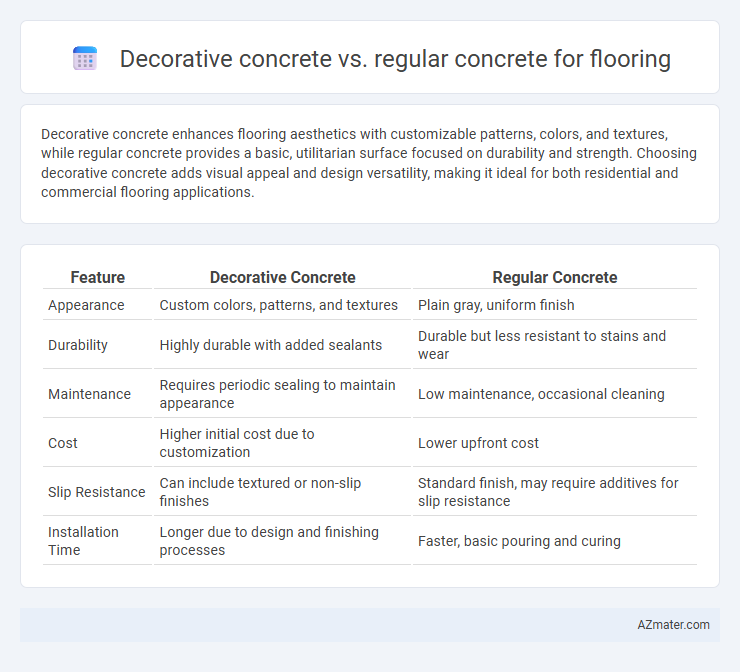Decorative concrete enhances flooring aesthetics with customizable patterns, colors, and textures, while regular concrete provides a basic, utilitarian surface focused on durability and strength. Choosing decorative concrete adds visual appeal and design versatility, making it ideal for both residential and commercial flooring applications.
Table of Comparison
| Feature | Decorative Concrete | Regular Concrete |
|---|---|---|
| Appearance | Custom colors, patterns, and textures | Plain gray, uniform finish |
| Durability | Highly durable with added sealants | Durable but less resistant to stains and wear |
| Maintenance | Requires periodic sealing to maintain appearance | Low maintenance, occasional cleaning |
| Cost | Higher initial cost due to customization | Lower upfront cost |
| Slip Resistance | Can include textured or non-slip finishes | Standard finish, may require additives for slip resistance |
| Installation Time | Longer due to design and finishing processes | Faster, basic pouring and curing |
Introduction to Decorative and Regular Concrete Flooring
Decorative concrete flooring enhances interior and exterior spaces through stamping, staining, or polishing techniques that provide unique textures, colors, and patterns, making it a versatile choice for designers and homeowners. Regular concrete flooring offers durability and cost-effectiveness with a plain, utilitarian surface commonly used in industrial, commercial, and residential settings. The selection between decorative and regular concrete depends on factors like aesthetic appeal, budget, maintenance, and the intended use of the flooring area.
Key Differences Between Decorative and Regular Concrete
Decorative concrete enhances flooring with various textures, colors, and patterns, providing aesthetic appeal alongside durability, unlike regular concrete which prioritizes strength and utility over appearance. Key differences include decorative concrete's use of stains, dyes, stamping, and polishing to create unique designs, whereas regular concrete typically remains plain and uniform. Maintenance requirements for decorative concrete often involve sealants to preserve look, while regular concrete focuses more on structural repairs and resurfacing.
Visual Appeal and Design Flexibility
Decorative concrete offers superior visual appeal and design flexibility compared to regular concrete, providing options like stamping, staining, and polishing to create intricate patterns and vibrant colors. It enables customization that mimics natural materials such as stone, brick, or wood, enhancing aesthetic value in both residential and commercial flooring applications. Regular concrete, while durable, lacks the ability to be easily customized, resulting in a more utilitarian and less visually engaging surface.
Durability and Performance Comparison
Decorative concrete flooring offers enhanced durability through advanced sealing techniques and additives that increase resistance to wear, stains, and moisture compared to regular concrete. High-performance decorative finishes such as epoxy coatings and stamped patterns improve slip resistance and aesthetic longevity, making them suitable for both residential and commercial spaces. Regular concrete, while strong, often requires additional treatments to match the resilience and low maintenance levels provided by decorative concrete solutions.
Installation Process: Decorative vs Regular Concrete
The installation process for decorative concrete involves additional steps such as stamping, staining, or engraving to create intricate patterns and textures, requiring skilled labor and extended curing times. Regular concrete installation is more straightforward, focusing primarily on pouring, leveling, and finishing the surface with fewer customization options and generally quicker completion. Decorative concrete demands precise surface preparation and detailed workmanship for aesthetic durability, while regular concrete prioritizes functionality and structural integrity.
Cost Analysis and Budget Considerations
Decorative concrete flooring typically incurs higher initial costs compared to regular concrete due to added materials, such as stains, dyes, and stamping tools, as well as specialized labor for design application. While regular concrete offers a more budget-friendly option with lower upfront expenses, it often requires additional finishing or sealing over time, potentially increasing maintenance costs. Evaluating long-term value, decorative concrete may deliver greater durability and aesthetic appeal, possibly reducing the need for future renovations and enhancing property value.
Maintenance Requirements and Longevity
Decorative concrete flooring offers enhanced durability and low maintenance compared to regular concrete, thanks to sealants and surface treatments that resist stains, cracks, and wear. Regular concrete requires more frequent sealing and patching to prevent damage from moisture and heavy foot traffic, leading to higher maintenance costs over time. Decorative options can last 25-50 years with minimal upkeep, while standard concrete often deteriorates faster under similar conditions.
Slip Resistance and Safety Factors
Decorative concrete for flooring offers enhanced slip resistance compared to regular concrete due to textured finishes, sealers, and anti-slip additives that improve traction. Safety factors are increased with decorative concrete as it reduces slip-and-fall accidents, especially in wet or high-traffic areas. Regular concrete tends to be smoother and more prone to becoming slippery when wet, posing greater safety risks.
Environmental Impact and Sustainability
Decorative concrete flooring often incorporates recycled materials and reduces the need for harsh chemical stains, making it a more environmentally friendly option compared to regular concrete. Its durability and low maintenance contribute to sustainable building practices by extending floor lifespan and minimizing resource consumption. In contrast, traditional concrete production generates higher carbon emissions due to cement manufacturing, increasing its environmental footprint.
Choosing the Best Concrete Flooring for Your Space
Decorative concrete offers customizable aesthetics with options like stamped patterns, stains, and dyes, making it ideal for enhancing the visual appeal of residential and commercial flooring. Regular concrete provides durable, cost-effective flooring suited for high-traffic areas where functionality takes precedence over style. Choosing the best concrete flooring depends on balancing budget, design goals, and the intended use of the space to ensure both performance and appearance meet specific needs.

Infographic: Decorative concrete vs Regular concrete for Flooring
 azmater.com
azmater.com